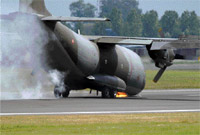A steep ‘tactical' landing approach went horribly wrong for an Italian air force pilot at the Royal International Air Tattoo (RIAT) on Saturday morning when he touched down hard on the nosewheel, bursting both tyres.

The subsequent ‘triple-kangaroo' down the runway collapsed the nose gear of the Alenia G-222 twin-engined transport aircraft and it eventually skidded to a standstill 700m down the runway with smoke and flames pouring from under the nose.
The pilot shut down both engines and all three crew members evacuated safely. Emergency vehicles were on the scene within one minute and the fire was quickly extinguished. The aircraft, from the Pratica di Mare airbase in southern Italy, sustained serious damage to the underside of the nose and couldn't be moved until a mobile crane lifted it onto a trolley using a sling.
Fortunately, damage to RAF Fairford's newly-resurfaced runway was relatively minor and the display resumed by mid-afternoon.
Commenting on the accident, Bob Dixon, deputy director of public affairs for RIAT says: "The safety of the public is always paramount at any airshow. As this incident demonstrated, the emergency services at RIAT are extremely professional. In addition, the strict supervision of the flying control committee ensures that the show achieves the highest levels of safety possible during an event of this nature."
Monster
But the general public – who had endured monster traffic queues and tight security before getting into the show in the first place – had to wait for several more hours before the mess was cleared and the runway reopened. Fortunately, several displays were possible during the hiatus, using a section of Fairford's extensive runway, and the RAF came to the rescue too by routing C-130 Hercules training flights for fly-past duties at the show!
RIAT is the world's largest military airshow. As well as being a major fund-raiser for the RAF Benevolent Fund, the 2002 event celebrated the Queen's Golden Jubilee and the 60th anniversary of the US Eighth Air Force.
The ‘Mighty Eighth' now operates Northrop Grumman B-2 Spirit, Rockwell B-1B and Boeing B-52 bombers but it's for its huge role in the Second World War that it's perhaps best remembered. Flying mainly from East Anglia and the north-east, the Eighth's B-17 Flying Fortresses and B-24 Liberators pounded the industries of Germany's Third Reich during daylight raids while the RAF took up the cudgels overnight.
Armada
By mid-1944, the Eighty Air Force formed the greatest air armada in history with a total strength of more than 200,000 people and capability of sending 2,000 four-engined bombers and 1,000 fighters on a single mission. More than 440,000 sorties were flown in daylight raids in the European heartland.
The ‘Mighty Eighth' suffered about half of all US Army Air Force casualties – 47,483 – including more than 26,000 who died.
Since the Second World War, the Eighth has boosted UN forces in Korea in the 1950s and taken part in the Vietnam War. During the Cold War, the Eighth's B-52s became symbols of freedom in the West, and it also played a prominent role in the Gulf War and the 1999 NATO campaign in Kosovo.
The recent Operation Enduring Freedom in Afghanistan has seen the 'Mighty Eighth' in action once again.
RIAT 2002 played host to an astonishing $8 trillion worth of aircraft, with 450 flying in from 35 nations. And as well as state-of-the-art aircraft from the world's air arms – including a fly-past from the B-2 Spirit and a lively display from the F-117A Stealth Nighthawk – the show featured top aerobatic teams from the UK, Italy, Spain, France, Italy, Jordan and Chile, while lovers of older machinery were treated to displays by an Avro Lancaster, a Bristol Blenheim, and a B-17 Flying Fortress.
Also flying were a Mustang, several Spitfires, a Hurricane and a Thunderbolt.
Source: Flight Daily News
















